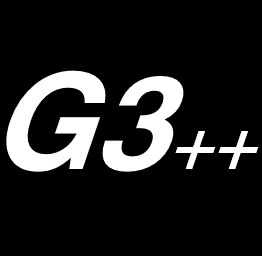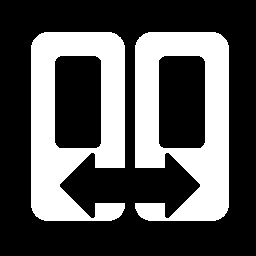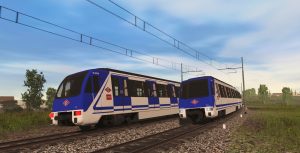DOWNLOAD
All the necessary dependencies are either included in this package or are avaible on the DLS. Soundscript by Rizky_Adiputra.
Missing a tracksound? Download this.
The 6000 Series was introduced in the late 1990s by Metro Madrid to operate services over the new south-eastern extension that would’ve brought Line 9 far into the outskirts of Madrid, up to the city of Arganda del Rey.
This rather rural city thruought the 1980s became the fulcrum of the massive Rivas-Vaciamadrid urbanization project, wich “landed” 100’000 additional residents in the area and grew the “old” Arganda del Rey to 50’000 inhabitants. Mass transit considerations were fundamentally secondary to the project, and this oversight quickly showed it’s limits, as the whole road network between Arganda del Rey and Madrid, via Rivas, became seriously congested. It was only then that providing mass transit, in the form of a railway, to the area became an urgent issue.
The only rail connection between Madrid and Arganda del Rey then in operation was trough the remnants of the Tajuña Railway, a narrow gauge line that connected Madrid to Auñón (a small town deep into the Alcarria mountains) whose passenger services were axed in the 1960s, and whose residual trackage remained in use as an industrial railway, carrying limestone from Morata de Tajuña to the Vicàlvaro plant of the Portland-Valderrivas Cement company. With the services ailing, the cement plant slated to eventually close and the concession for the railway due to expiry in 1996, it was soon clear that the most rational course of action would’ve been to reuse the line, or it’s alignment.
Three possible projects were proposed in the late 1980s concerning the future railway liason between Arganda del Rey and Madrid: one called for the Tajuña Railway to be taken over by FEVE “as is”, with the narrow gauge being kept and a relatively limited number of major modifications to be made, making it the cheapest option. Another called for the line to be converted to the 1668mm “Iberian Gague”, electrified and handed over to RENFE, wich would’ve run it as part of the Madrid Cercanìas commuter network. The third and last called for the right-of-way to be taken over by a south-eastern extension of Line 9 of the Madrid Metro network, wich was already planned to reach Vicàlvaro station. Ultimately, the “Madrid Metro” option prevailed – the “FEVE proposal” was discarded as it was likely deemed insufficient (FEVE also having a rather poor reputation in managing commuter railways – all of wich were being taken over by the various spanish regional governments at the time) and the “RENFE proposal” was discared as it was likely considered too complicated (and costly) to implement, especially due to capacity constraints over the existing network around Madrid, and also because the national government (to wich RENFE ultimately answered), trough the Ministy of Pubblic Works, was not interested in the proposal.
With the expiry of the concession and the closure of the cement plant in Vicàlvaro, the Tajuña Railway ceased all services on the 7th of November 1997, with it’s right-of-way being immediately purchased by the Community of Madrid, with construction works to accomodate the new Line 9 extension commencing soon after. Due to financial constraints however, it was decided that this section of the line would not be managed by Metro Madrid, but built and operated as part of a “Project Financing” initiative by a consortium of pubblic and private entities: Transportes Ferroviarios de Madrid (TFM, or “Madrid Rail Transit”), formed by Metro Madrid (wich would manage and operate the line), Caja Madrid (a bank and major financier of the project) and Acciona, FCC and ACS (the construction contractors).
Line 9’s new route to Arganda del Rey was to be rather different from the rest of the Madrid Metro, with long intra-station distances allowing for higher speeds, while requiring higher seating capacity, two factors that Metro Madrid’s wide-profile (as was Line 9) rolling stock could not meet – the three sub-series of the 5000 Series family (the 5000 Series, the 5200 Series and the then-brand-new 5500 Series) had been all built to a common design for busy, “urban” subway lines with close station spacing, and as such had a maximium speed of only 70Km/h as well as entirely longitudinal seating to maximise passenger loads. Taking into account that, even if gradually updated, the base design for it’s current wide-profile fleet was fundamentally over 20 years old, Metro Madrid ultimately decided to opt for an entirely new design, specifically tailored to Line 9’s requirements.
The designing and construction of the new trains, classified as the “6000 Series” was entrusted to CAF, as was established practice, with some slight technical assistance by Alsthom. Traction equipment was instead sourced from Siemens and control electronics were designed and provided by ADtranz.
The fundamental base idea for the 6000 Series was to have a train that could perform equally well on both “intra-urban” services with frequent stops as well as “suburban”-like services with higher speeds and longer intra-station distances, corresponding the two “sides” of Line 9. As such, the train was designed with a 110Km/h top speed and four-by-four cross-seating bays for the “suburban” stretch, while retaining the four doors per side for the “urban” sections. Having completely ditched the boxy base design of the 5000 Series and it’s successors, a new bodyshell style was adopted for the 6000 Series, fetauring a pleasantly curved and aereodynamic front, as well as a slightly tapered cross-section. A number of new fetaures were also implemented on the 6000 Series, most notably walk-trough open-gangways between cars, as well as air conditioning and the fitting of an on-board event recorder (making it the first Madrid Metro train to be fitted with each of the three fetaures).
Built between 1998 and 1999 for a total of 44 two-car sets (88 total cars) the 6000 Series was delivered to Metro Madrid and, after some delays due to the need to refine the sophisticated control electronics, entered service on the “TFM” section of Line 9 after it’s opening on the 7th of April 1999. Soon after, as their usage “spread” to the rest of Line 9, between 2002 and 2003 all trains were lenghtened from two to three-car sets with the addition of an intermediate trailer, built to the same fundamental design but with longitudinal seating instead. For the following decade, their service remained relatively uneventful, even if punctuated by some reliability issues (primarily with the control electronics).
In the early 2010s however, a major shake-up of the 6000 Series fleet happened – with Metro Madrid gripped by a financial near-crisis (as the direct result of the gargantuan expansion efforts that had been taken place right up until then, and the immediately subsequent 2008 financial crisis and following recession), the company decided to offset part of it’s accumulated debts by selling off surplus assets, including rolling stock. While the primary candidates for these “sell-offs” were withdrawn, no-longer-in-service, trains, a good chunk of the 6000 Series fleet was also put on sale, the reason being that fleet was deemed to be oversized in relation to the actual operational necessities of both Line 9 “proper” (historically the least-used “major” line, due to it’s peripheral alignment bypassing Madrid’s city center) as well as for the “TFM” section, wich saw an even more limited number of passengers.
Thus, a total of 86 cars out of 132 manufactured (72 “M”-cars and 14 “R” trailer cars) were put on sale, being purchased by the city of Buenos Aires for use on it’s “Subte” Line B, joining the other ex-Madrid 5000 Series trains previously purchased, with the aim of replacing the ageing “Mitsubishi” trains (former TRTA Marunouchi Line 500 Series sets) dating from the 1950s and purchased second-hand from Japan in the mid-1990s.
The remaining 16 “M”-cars and a handful of trailers were retained by Metro Madrid and confined to the “TFM” section (marked as “Line 9B” on maps) of Line 9, from Puerta de Arganda to Arganda del Rey (wich had been separated operationally from the rest of the line early on due to the much lower ridership) where they still operate to this day as either two- or three-car sets, having been replaced on the “main” section of Line 9 (from Puerta de Arganda north to Paco de Lucia) initially by surplus 5500 Series sets transferred from Line 6, and ultimately by the AnsaldoBreda-made 7000 Series.
This situation has remained essentially unchanged to this day, with the 6000 Series still confined to the “TFM” section, with the thin residual fleet providing the entirety of services over it. The over-sale of the 6000 Series fleet has left also quite the issue with it’s size, wich as of today is barely enough for the current requirements of the “TFM” section. With the end of the TFM concession looming in 2029, quite auspicated by the users of the line due to the poor service (directly due to the rolling stock shortage), Metro Madrid has plans to restore trough-running between the “TFM” section and the rest of Line 9, wich will likely necessitate new rolling stock. At that time, the 6000 Series will have just passed the 30 year mark, and as such, a retirement to the profit of newer rolling stock (likely the 8000 Series cascaded from the automation of Line 6) might not be too far-fetched.
Bonus:
Despite having been functionally “confined” to Line 9 in revenue service, the 6000 Series trains can still run over the whole wide-profile Madrid Metro network, and they occasionally do move trough other lines to reach other depots and workshops for maintainance and overhauls. Here’s an example, a 6000 Series train on the trackage of Line 6, going trough Principe Pio station, likely coming from Laguna Depot and heading back to Line 9 via the connecting track between Line 6 and Line 9 at Sainz de Baranda station.




